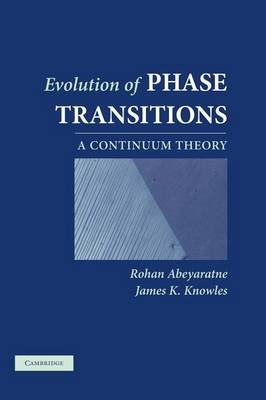
Evolution of Phase Transitions
Cambridge University Press (Verlag)
978-0-521-66147-8 (ISBN)
This 2006 work began with the author's exploration of the applicability of the finite deformation theory of elasticity when various standard assumptions such as convexity of various energies or ellipticity of the field equations of equilibrium are relinquished. The finite deformation theory of elasticity turns out to be a natural vehicle for the study of phase transitions in solids where thermal effects can be neglected. This text will be of interest to those interested in the development and application of continuum-mechanical models that describe the macroscopic response of materials capable of undergoing stress- or temperature-induced transitions between two solid phases. The focus is on the evolution of phase transitions which may be either dynamic or quasi-static, controlled by a kinetic relation which in the framework of classical thermomechanics represents information that is supplementary to the usual balance principles and constitutive laws of conventional theory.
Rohan Abeyaratne is the Quentin Berg Professor and Department Head of Mechanical Engineering at the Massachusetts Institute of Technology. Among his many honors are: E.O.E. Pereira Gold Medal, 1975; Den Hartog Distinguished Educator, 1995; Fellow, American Academy of Mechanics; 1996 Fellow, ASME, 1998; MacVicar Faculty Fellow, 2000. His research focuses include Continuum Mechanics; Finite Elasticity and Plasticity; Material Instability and Non-Equilibrium Behavior of Solids; Stress-Induced Phase Transformations in Solids, and Cavitation. Professor James K. Knowles is the William R. Kenan, Jr. Professor of Applied Mechanics. He received his Ph.D. from the Massachusetts Institute of Technology, D.Sc.h.c., National University of Ireland, and has received the following awards: Goodwin Medal for Effective Teaching, MIT (1955), Award of the Associated Students of Caltech for Excellence in Teaching (1984, 1985), Award of the Caltech Graduate Student Council for Exceptional Teaching (1993); Fellow, American Academy of Mechanics; Fellow, American Society of Mechanical Engineers; President of the American Academy of Mechanics, 1985-86; Eringen Medal, Society of Engineering Science (1991). He is the author of Linear Vector Spaces and Cartesian Tensors (1997) and numerous articles in refereed journals.
Part I. Introduction: 1. What this monograph is about; 2. Some experiments; 3. Continuum mechanics; 4. Quasilinear systems; 5. Outline of monograph; Part II. Two-Well Potentials, Governing Equations and Energetics: 1. Introduction; 2. Two-phase nonlinearly elastic materials; 3. Field equations and jump conditions; 4. Energetics of motion, driving force and dissipation inequality; Part III. Equilibrium Phase Mixtures and Quasistatic Processes: 1. Introduction; 2. Equilibrium states; 3. Variational theory of equilibrium mixtures of phases; 4. Quasistatic processes; 5. Nucleation and kinetics; 6. Constant elongation rate processes; 7. Hysteresis; Part IV. Impact-Induced Transitions in Two-Phase Elastic Materials: 1. Introduction; 2. The impact problem for trilinear two-phase materials; 3. Scale-invariant solutions of the impact problem; 4. Nucleation and kinetics; 5. Comparison with experiment; 6. Other types of kinetic relations; 7. Related work; Part V. Multiple-Well Free Energy Potentials: 1. Introduction; 2. Helmholtz free energy potential; 3. Potential energy function and the effect of stress; 4. Example 1: the van der Waals fluid; 5. Example 2: two-phase martensitic material with cubic and tetragonal phases; Part VI. The Continuum Theory of Driving Force: 1. Introduction; 2. Balance laws, field equations and jump conditions; 3. The second law of thermodynamics and the driving force; Part VII. Thermoelastic Materials: 1. Introduction; 2. The thermoelastic constitutive law; 3. Stability of a thermoelastic material; 4. A one-dimensional special case: uniaxial strain; Part VIII. Kinetics and Nucleation: 1. Introduction; 2. Nonequilibrium processes, thermodynamic fluxes and forces, kinetic relation; 3. Phenomenological examples of kinetic relations; 4. Micromechanically-based examples of kinetic relations; 5. Nucleation; Part IX. Models for Two-Phase Thermoelastic Materials in One Dimension: 1. Preliminaries; 2. Materials of Mie-Gruneisen type; 3. Two-phase Mie-Gruneisen materials; Part X. Quasistatic Hysteresis in Two-Phase Thermoelastic Tensile Bars: 1. Preliminaries; 2. Thermomechanical equilibrium states for a two-phase material; 3. Quasistatic processes; 4. Trilinear thermoelastic material; 5. Stress cycles at constant temperature; 6. Temperature cycles at constant stress; 7. The shape-memory cycle; 8. The experiments of Shaw and Kyriakides; 9. Slow thermomechanical processes; Part XI. Dynamics of Phase Transitions in Uniaxially Strained Thermoelastic Solids: 1. Introduction; 2. Uniaxial strain in adiabatic thermoelasticity; 3. The impact problem; Part XII. Statics: Geometric Compatibility: 1. Preliminaries; 2. Examples; Part XIII. Dynamics: Impact-Induced Transition in a CuA1Nl Single Crystal: 1. Introduction; 2. Preliminaries; 3. Impact without phase transformation; 4. Impact with phase transformation; 5. Application to austenite-B1 martensite transformation in CuA1Nl; Part XIV. Quasistatics: Kinetics of Martensitic Twinning: 1. Introduction; 2. The material and loading device; 3. Observations; 4. The model; 5. The energy of the system; 6. The effect of the transition layers: further observations; 7. The effect of the transition layers: further modeling; 8. Kinetics.
| Erscheint lt. Verlag | 8.5.2006 |
|---|---|
| Verlagsort | Cambridge |
| Sprache | englisch |
| Maße | 178 x 254 mm |
| Gewicht | 670 g |
| Themenwelt | Naturwissenschaften ► Physik / Astronomie ► Festkörperphysik |
| Technik ► Maschinenbau | |
| ISBN-10 | 0-521-66147-1 / 0521661471 |
| ISBN-13 | 978-0-521-66147-8 / 9780521661478 |
| Zustand | Neuware |
| Haben Sie eine Frage zum Produkt? |
aus dem Bereich


